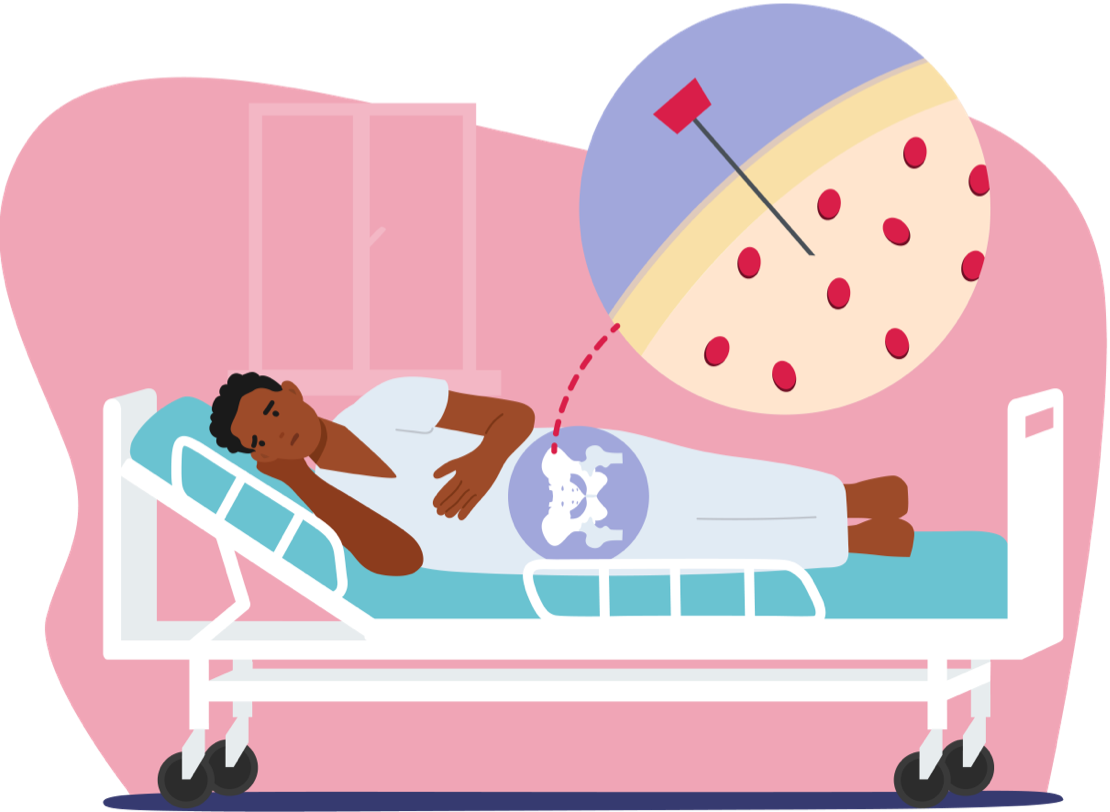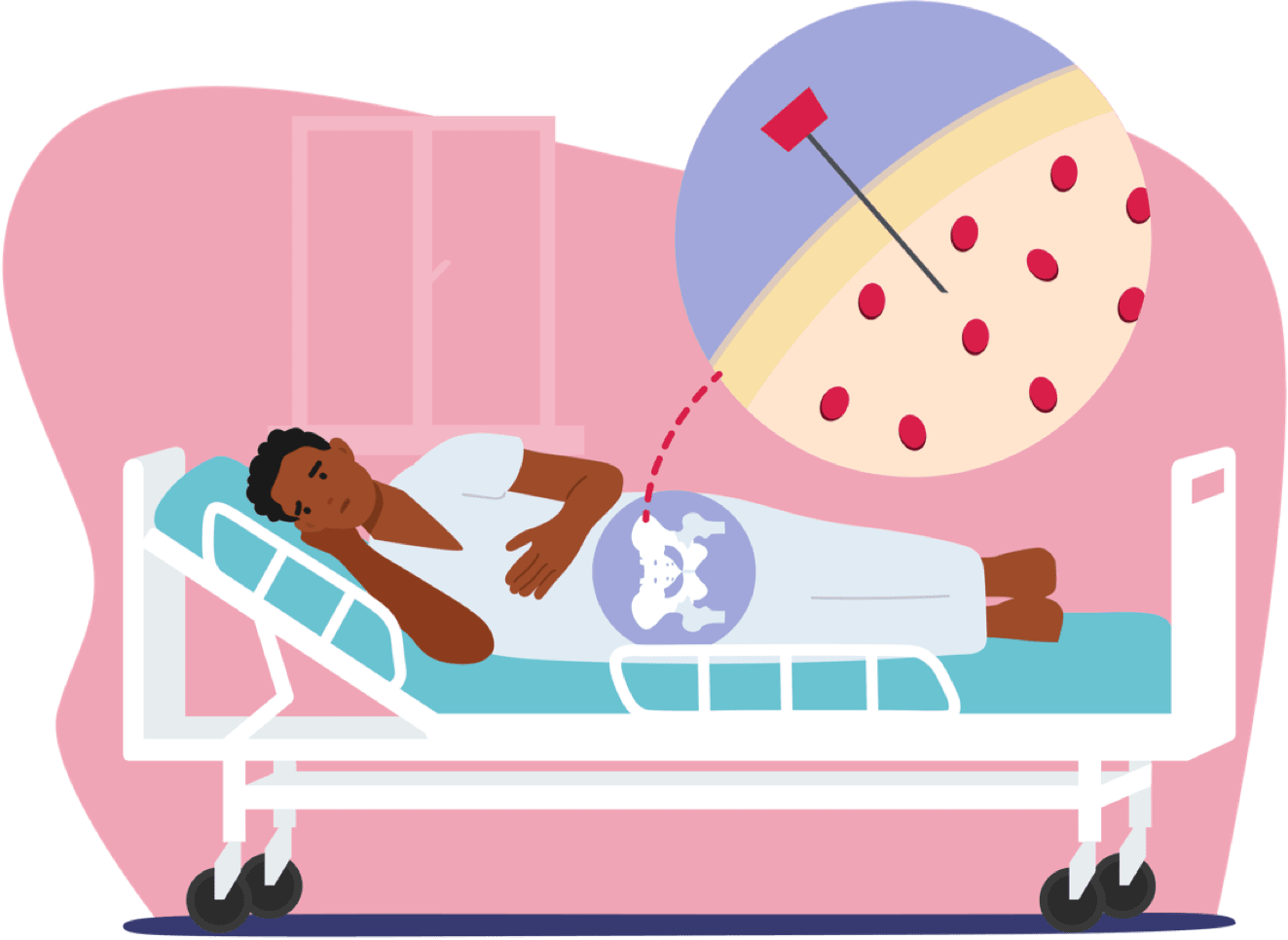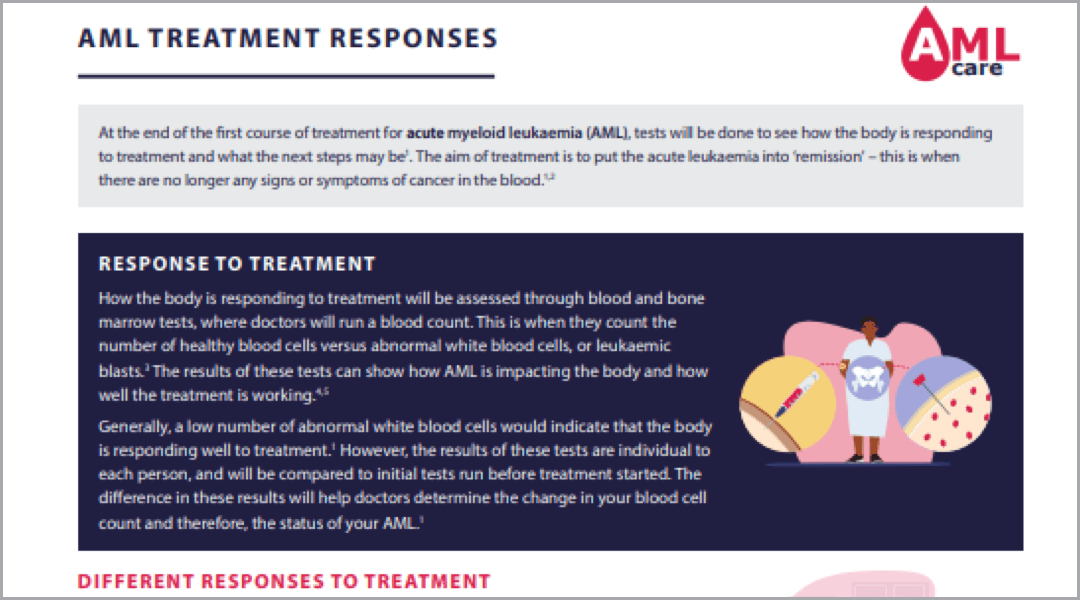Bone marrow tests
Taking cells from within the bone marrow, the soft, spongy inner part of our larger bones, is known as a bone marrow test or biopsy.1
Why is it done?
Bone marrow tests are done regularly to help doctors understand two crucial things:
WHETHER AML IS PRESENT
Bone marrow tests show how many of your white blood cells are healthy and how many are abnormal.1
THE TYPE OF AML
Carrying out special genetic tests on the blood cells in the bone marrow will give doctors valuable information on the subtype of AML – this allows doctors to tailor treatment.2,3
Is AML inherited?
The genetic changes in blood cells with leukaemia are usually not inherited, meaning it’s extremely rare for them be passed onto children or future generations. Instead, they usually occur randomly and can happen to anyone at any point.
The Terminology Explained document is available to explain any words or phrases you don’t fully understand.
How are bone marrow tests taken?


In hospital, bone marrow samples are usually taken from the hip area.1 This is one of the biggest bones in the body, with easy access for doctors to get a good sample. The doctor will cleanse the area and use local anaesthetic – a medication that numbs the hip.4
Once the area is numb, the nurse or doctor will do two things:4
1. An aspiration. This is when a hollow needle is inserted into the bone marrow and a small liquid sample of bone marrow is removed. The needle is roughly the size of the inner tube of a biro pen - much smaller than you may think.1,2
2. A trephine. This is when a thin piece of core bone marrow is removed.4 Some people feel a tingling feeling in their feet when this part is being done.


Both samples are taken at the same time and it will take 20–30 minutes to complete the procedure.2 The hip area may be uncomfortable for a few weeks after, this is normal but it is recommended to speak with a doctor if it is getting worse, or you are particularly worried. Usually, doctors will tell you when to expect the results for each part of the procedure. It may be that you get one result back before the other, and treatment may start before all the final results are back.4
Seven helpful tips before your next bone marrow test
Helpful tips before your next bone marrow test
1. NERVES
If you are feeling nervous, let your doctor or nurse know. They have done this many times before and will know the best way to put your mind at ease.
2. DISTRACTIONS
Try distracting yourself during the test. For example, take headphones and listen to music or a podcast.
3. DISCOMFORT
The bone marrow test process can be uncomfortable.5 If you feel any discomfort during or after the test, speak to your doctor about how it can be alleviated.
4. ACTIVITY
Make sure to avoid intense activity afterwards.
5. QUESTIONS
Remember, there is no such thing as a silly question. Your doctors and nurses may use new words that you’ve not heard of – if you don’t know what they mean, just ask. There is no expectation that you will remember everything, so don’t worry about asking the same question again.
6. PREPARATION
If you have questions, make sure you write them down. It can be easy to forget things when you’re speaking with your nurses and doctors.
7. SUPPORT
Remember, you can take a member of your family, a friend, a carer or someone to support you to your clinic appointment. They can ask any questions you don’t want to or forget. Why not look at this checklist of questions to start with.
Support material

Understanding tests to diagnose AML
Download our handy one-pager, packed with information to help you or your loved one understand the tests used to check blood counts and monitor AML.

Questions to ask your doctor about the tests
Try taking this to your next appointment to guide the conversation and keep you in the loop.
Josh’s journey
Josh experienced a very quick diagnosis. Hear the advice he has for others who have just been diagnosed with AML.
Find out more about
Coming to terms with an AML diagnosis
Find out more information here
Blood test
What is a blood test? How is it taken? What can I do to prepare? Find the answers to these questions and more.
References
1. Leukemia and Lymphoma Society. Acute Myeloid Leukemia in Adults. https://www.lls.org/sites/default/files/2021-09/PS32_AML_Booklet_Adult_2021.pdf [Last Accessed: April 2022]
2. NHS. Acute Myeloid Leukaemia Diagnosis. https://www.nhs.uk/conditions/acute-myeloid-leukaemia/diagnosis/. [Last accessed April 2022]
3. Mrózek K, Marcucci G, Nicolet D, et al. Prognostic significance of the European LeukemiaNet standardized system for reporting cytogenetic and molecular alterations in adults with acute myeloid leukemia. J Clin Oncol. 2012;30(36):4515-4523.
4. Cancer Research UK. Bone marrow test. https://www.cancerresearchuk.org/about-cancer/acute-myeloid-leukaemia-aml/getting-diagnosed/tests/bonemarrow-test [Last accessed April 2022]
5. Percival ME, Lai C, Estey E, et al. Bone marrow evaluation for diagnosis and monitoring of acute myeloid leukemia. Blood Rev. 2017; 31(4):185-192
HAE_2022_0032_IE | April 2022

